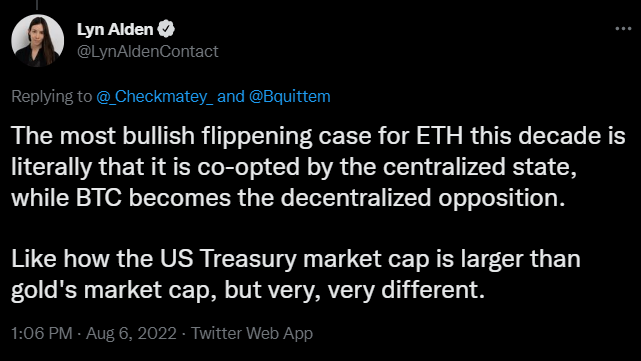Moving the Ethereum protocol from proof-of-work to proof-of-stake will end in a disaster.
If you are a big believer in Ethereum, you may think an article published on BitcoinNews.com would biased or pure propaganda. Therefore I’d like to disclose that I hold 10% of my portfolio in Ethereum or assets built on Ethereum which allows me to write objectively and see both sides of the argument.
I’m interested to discuss arguments not opinions and emotions and my goal is to help advance decentralization and resist central control.
Ethereum Can’t Return To POW After The Merge
Once Ethereum moves to POS it will impossible if not extremely hard to move back to POW (it’s a one-way street). Moreover, moving to POS will make regulatory capture much more likely. It has already begun with the US announcing sanctions against currency mixer Tornado Cash (mixing services help users to become more private, given most Ethereum purchases are done through KYC exchanges which identify the user).
Running A POS Node Could Cost $160.000
Running your own node will get harder, riskier and more expensive on POS, given that you need 32 Eth to run a node. Assuming Ethereum is valued at $5,000 that would require a pleb to stake $160,000 from their stash.
Would regular users like you and me be comfortable running a node from our laptop valued at $160,000?
Price is the main factor, however, technical know-how is the second major factor. Running a node on POS is not as straightforward as running a POW node.
Therefore, It will be more convenient to pass on this risk to exchanges or staking services like Binance and Lido. This will push everything towards more centralisation which again makes increases the risk of regulatory capture.
With bitcoin and proof-of-work, it is extremely easy, simple and cost-effective to run your own Bitcoin(BTC) node.
Stalessness And Pruning Doesn’t Solve The Problem
In addition, the issue of ‘Statelessness’ arises. Statelessness is a proposal to use pruning, a lighter version of the validation process. So, given you gain the technical know-how and have the appetite to take the risk to leave $160,000 on your laptop and then decide to run your node on Ethereum’s POS system, you would still have to place trust in other validators.
Let’s be honest, most Bitcoiners struggle to lock 1 million sats in a lightning channel as it they feel their funds could be at risk. Even if Ethereum stays a $1,000, using $32,000 to run a Ethereum node is just out of reach for many people.
As Ethereum 2.0 aims to become the world’s computer which would easily amount to 100 GBs of data per day (that is within 5-6 days surpassing Bitcoin(BTC)’s entire history), there’s no way a regular computer could deal with it, hence the proposal to prune the history.
This pruning process leads to creating a system of checkpoints (which is agreeing on points in history) and when new nodes are switched on they have to trust these checkpoints and validators that create these checkpoints. However, what happens if existing validators are captured, now you have a problem since you can not validate the network from history zero.
On the Bitcoin(BTC) network, a full node automatically downloads all the history starting from Satoshis’ Genesis block, thus eliminating the need for you to trust other nodes. The node verifies everything for itself, it can validate the history from block zero to the latest block without the need of a third-party. Moreover, it can be switched off anytime and when it is switched back on it can easily catch-up and synch with the status-quo.
Incentives In POS Lead To Further Centralization
On POW miners have to sell the coinbase (mining) rewards due to running costs (energy and hardware) which in turn creates healthy dilutions of bitcoin issuance. On a POS system, stakers have no need to sell their rewards and additionally they are incentivised to hold on to their rewards. This creates the same ‘Cantillion’ problem which we are currently in with the fiat money system. The rich get richer and the poor poorer (as staking rewards are in proportion to the amount of eth staked).
This will inevitably result in giving large stakers (which are institutional stakers) more control over the network or in other words leading once again to more centralisation.
Lastly, let’s look at the current percentage of staked ETH. Currently, Lido has 31.6% staked ETH, and Binance + Coinbase + Kraken + Lido has over 7.92m ETH stake which is 60.2%, again creating mega exposure for regulatory capture.
Moreover, 67% of the network is required to approve blocks, in other words, 67% of the network can reject competing blocks which are generated by the remaining 33%. Blocks can be rejected based on KYC compliance, not meeting regulatory guidelines and other top-down control mechanisms.

Source – @_Checkmatey_
Other factors that further tread toward centralisation
- Existing validators have to vote for new validators. In other words, existing validators can hold new validators hostage.
- Bad actors/validators/stakers are punished by means of slashing, but can you really slash staking pools that are holding the value of innocent plebs
It doesn’t surprise me that the World Economic Forum supports POS as it will turn Ethereum into something that, just like fiat money, gives total control to the central planners.




